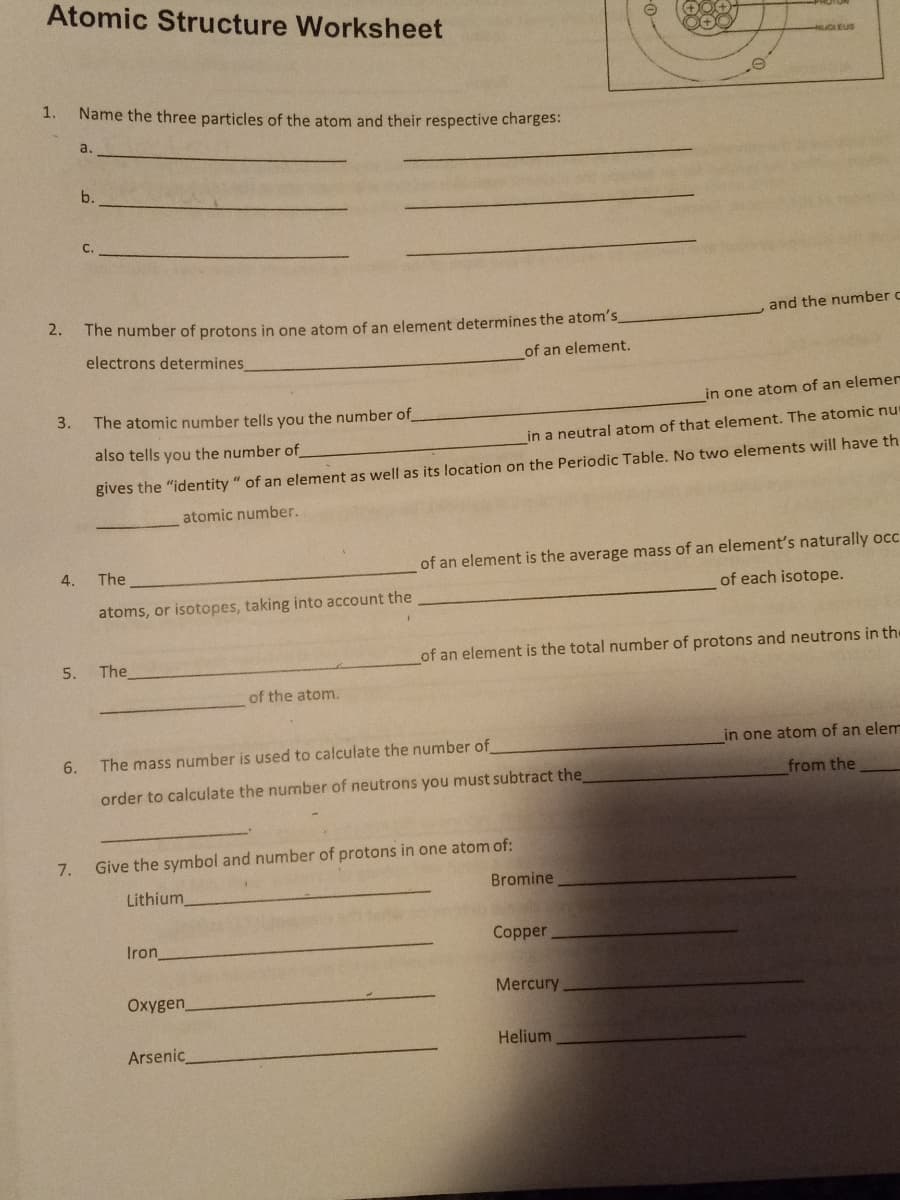O. 1. Name the three particles of the atom and their respective charges: a. C. and the number 2. The number of protons in one atom of an element determines the atom's electrons determines_ of an element. in one atom of an elemer 3. The atomic number tells you the number of in a neutral atom of that element. The atomic nur also tells you the number of gives the "identity" of an element as well as its location on the Periodic Table. No two elements will have th atomic number. ploment's naturally occ b.
O. 1. Name the three particles of the atom and their respective charges: a. C. and the number 2. The number of protons in one atom of an element determines the atom's electrons determines_ of an element. in one atom of an elemer 3. The atomic number tells you the number of in a neutral atom of that element. The atomic nur also tells you the number of gives the "identity" of an element as well as its location on the Periodic Table. No two elements will have th atomic number. ploment's naturally occ b.
Principles of Modern Chemistry
8th Edition
ISBN:9781305079113
Author:David W. Oxtoby, H. Pat Gillis, Laurie J. Butler
Publisher:David W. Oxtoby, H. Pat Gillis, Laurie J. Butler
Chapter2: Chemical Formulas, Equations, And Reaction Yields
Section: Chapter Questions
Problem 17P: A gaseous binary compound has a vapor density that is 1.94 times that of oxygen at the same...
Related questions
Question
Name the

Transcribed Image Text:Atomic Structure Worksheet
1.
Name the three particles of the atom and their respective charges:
a.
b.
and the number c
2.
The number of protons in one atom of an element determines the atom's
electrons determines
of an element.
in one atom of an elemer
3.
The atomic number tells you the number of
in a neutral atom of that element. The atomic nu
also tells you the number of
gives the "identity" of an element as well as its location on the Periodic Table. No two elements will have th
atomic number.
The
of an element is the average mass of an element's naturally occ
of each isotope.
atoms, or isotopes, taking into account the
of an element is the total number of protons and neutrons in the
5.
The
of the atom.
in one atom of an elem
6.
The mass number is used to calculate the number of
order to calculate the number of neutrons you must subtract the
from the
7.
Give the symbol and number of protons in one atom of:
Bromine
Lithium
Copper
Iron_
Mercury
Oxygen_
Helium
Arsenic
4.
Expert Solution
This question has been solved!
Explore an expertly crafted, step-by-step solution for a thorough understanding of key concepts.
This is a popular solution!
Trending now
This is a popular solution!
Step by step
Solved in 2 steps with 2 images

Knowledge Booster
Learn more about
Need a deep-dive on the concept behind this application? Look no further. Learn more about this topic, chemistry and related others by exploring similar questions and additional content below.Recommended textbooks for you

Principles of Modern Chemistry
Chemistry
ISBN:
9781305079113
Author:
David W. Oxtoby, H. Pat Gillis, Laurie J. Butler
Publisher:
Cengage Learning

Introductory Chemistry: A Foundation
Chemistry
ISBN:
9781337399425
Author:
Steven S. Zumdahl, Donald J. DeCoste
Publisher:
Cengage Learning

Chemistry & Chemical Reactivity
Chemistry
ISBN:
9781133949640
Author:
John C. Kotz, Paul M. Treichel, John Townsend, David Treichel
Publisher:
Cengage Learning

Principles of Modern Chemistry
Chemistry
ISBN:
9781305079113
Author:
David W. Oxtoby, H. Pat Gillis, Laurie J. Butler
Publisher:
Cengage Learning

Introductory Chemistry: A Foundation
Chemistry
ISBN:
9781337399425
Author:
Steven S. Zumdahl, Donald J. DeCoste
Publisher:
Cengage Learning

Chemistry & Chemical Reactivity
Chemistry
ISBN:
9781133949640
Author:
John C. Kotz, Paul M. Treichel, John Townsend, David Treichel
Publisher:
Cengage Learning

Chemistry & Chemical Reactivity
Chemistry
ISBN:
9781337399074
Author:
John C. Kotz, Paul M. Treichel, John Townsend, David Treichel
Publisher:
Cengage Learning

Chemical Principles in the Laboratory
Chemistry
ISBN:
9781305264434
Author:
Emil Slowinski, Wayne C. Wolsey, Robert Rossi
Publisher:
Brooks Cole

Chemistry: Matter and Change
Chemistry
ISBN:
9780078746376
Author:
Dinah Zike, Laurel Dingrando, Nicholas Hainen, Cheryl Wistrom
Publisher:
Glencoe/McGraw-Hill School Pub Co